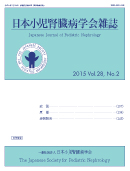Volume 28, Issue 2
Displaying 1-11 of 11 articles from this issue
- |<
- <
- 1
- >
- >|
Reviews
-
2015Volume 28Issue 2 Pages 107-113
Published: 2015
Released on J-STAGE: November 15, 2015
Advance online publication: August 20, 2015Download PDF (1628K) -
2015Volume 28Issue 2 Pages 114-119
Published: 2015
Released on J-STAGE: November 15, 2015
Advance online publication: November 04, 2015Download PDF (752K) -
2015Volume 28Issue 2 Pages 120-128
Published: 2015
Released on J-STAGE: November 15, 2015
Advance online publication: November 04, 2015Download PDF (796K) -
2015Volume 28Issue 2 Pages 129-133
Published: 2015
Released on J-STAGE: November 15, 2015
Advance online publication: November 04, 2015Download PDF (5651K)
Original Articles
-
2015Volume 28Issue 2 Pages 134-139
Published: 2015
Released on J-STAGE: November 15, 2015
Advance online publication: October 09, 2015Download PDF (1581K) -
2015Volume 28Issue 2 Pages 140-144
Published: 2015
Released on J-STAGE: November 15, 2015
Advance online publication: October 09, 2015Download PDF (899K)
Case Reports
-
2015Volume 28Issue 2 Pages 145-150
Published: 2015
Released on J-STAGE: November 15, 2015
Advance online publication: October 09, 2015Download PDF (1558K) -
2015Volume 28Issue 2 Pages 151-157
Published: 2015
Released on J-STAGE: November 15, 2015
Advance online publication: November 04, 2015Download PDF (1831K) -
2015Volume 28Issue 2 Pages 158-163
Published: 2015
Released on J-STAGE: November 15, 2015
Advance online publication: October 09, 2015Download PDF (2344K) -
2015Volume 28Issue 2 Pages 164-168
Published: 2015
Released on J-STAGE: November 15, 2015
Advance online publication: October 09, 2015Download PDF (833K) -
2015Volume 28Issue 2 Pages 169-175
Published: 2015
Released on J-STAGE: November 15, 2015
Advance online publication: November 04, 2015Download PDF (3445K)
- |<
- <
- 1
- >
- >|
